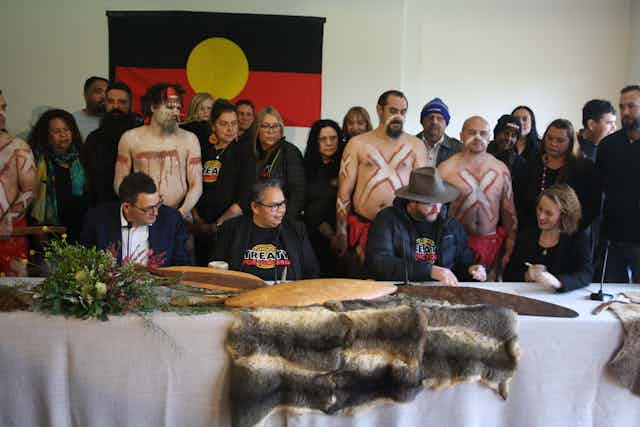Last week the Victorian government demonstrated its commitment to build an equal relationship with First Peoples. A new bill has been tabled in the Victorian parliament to advance the Victorian treaty processes.
In 2018, legislation was enacted that required the First Peoples’ Assembly of Victoria and the Victorian government to work together to establish a Treaty Authority.
The new bill further affirms the Assembly and the Victorian government’s agreement and commitment to establish a Treaty Authority and support its operations.
The new Treaty Authority will be the first of its kind in Australia, placing First Peoples’ culture at the heart of its practices.
Read more: Queensland's 'Path to Treaty' has some lessons for the rest of Australia
What is the Treaty Authority and how will it work?
The significant power difference between the government and First Nations people means there needs to be a way to establish equal footing for treaty negotiations.
The Treaty Authority serves that role as an institution independent of parliament and government.
Negotiations may well be long and complex. The authority will oversee treaty negotiations and if the parties cannot agree on particular matters or the appropriate process, it will act as an independent umpire to help resolve the issue.
The new authority will respect First Peoples’ culture with a focus on dialogue. Talking through problems to achieve agreement, rather using than a combative approach, is at the core of the treaty process.
Assembly co-chair and Nira illim bulluk man Marcus Stewart said the Treaty Authority
will be guided by Aboriginal lore, law and cultural authority that has been practised on these lands for countless generations.
This is a significant development in Australian legal institutions and processes. It addresses well known problems with the adversarial nature of native title determinations, where traditional owners must sue the government to prove their title.
This new public law process appropriately recognises the standing of Indigenous cultural approaches.
In another important development, the Treaty Authority will have guaranteed government funding, which it controls and manages. This will ensure the authority can perform its functions long-term.
In the past when governments set up bodies to assist First Nations, there were problems with sustainability, because the body did not have the resources to function. It is encouraging to see the commitment at this early stage, to continuous funding and First Nations’ control.
The Treaty Authority will be comprised of independent members who are all First Peoples, who will be selected after a public call for nominations.
Read more: Voice to Parliament design report still doesn't meet international human rights standards
The Treaty Authority recognises the right to self-determination
Indigenous rights expert Professor Megan Davis explained
before Indigenous Australia can participate in the Australian democratic project on just and equal terms, the unresolved issues of the colonial project and the psychological terra nullius of Australia’s public institutions must be finally dealt with.
The Treaty Authority will be a public institution that grapples with this problem of “psychological terra nullius” – the exclusion of First Nations peoples in politics and law.
It forms part of the broader work to provide just and equal participation by First Peoples in our democratic institutions. It complements the First Peoples’ Assembly of Victoria, and the Yoorrook Justice Commission, which address voice and truth respectively.
All of these institutions are part of the overarching treaty process in Victoria.
Treaty is one important way of realising Indigenous peoples’ right to self-determination.
Self-determination means the right of a people to make decisions about their own governance and way of life.
Self-determination for Indigenous peoples is also a requirement of the United Nations Declaration on the Rights of Indigenous Peoples, and other international human rights law.
By drawing on First Nations’ “law, lore, and cultural authority” in order to support the treaty process, the Victorian Treaty Authority is demonstrating an innovative approach to realising First Peoples’ right to self-determination.
Navigating a way to treaty
Victoria is only one Australian jurisdiction currently navigating treaty processes. Queensland, the Northern Territory, South Australia, and Tasmania are all embarking on pathways to treaty.
And the new Albanese government is working to deliver on its commitment to the Uluru Statement from the Heart’s call for Voice, Treaty, and Truth at the federal level.
Each of these processes should properly be informed by respective First Peoples in each area.
For all jurisdictions, the Victorian approach demonstrates the potential for transformative institutional reform, in and beyond government.
Self-determination must be led by sovereign First Nations people and grounded in Indigenous culture and law. International human rights law requires it. And justice alone demands the state, in all its guises, enters into proper relations with the First Nations of this land.

